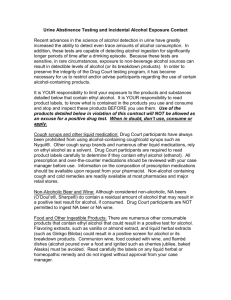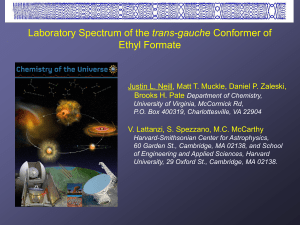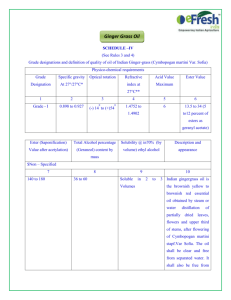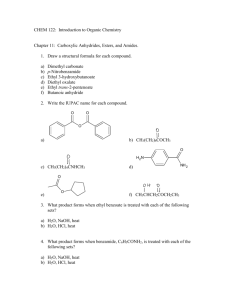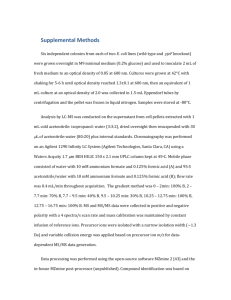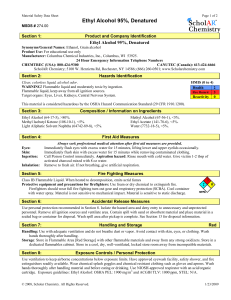Postharvest Control of Western Flower Thrips
advertisement
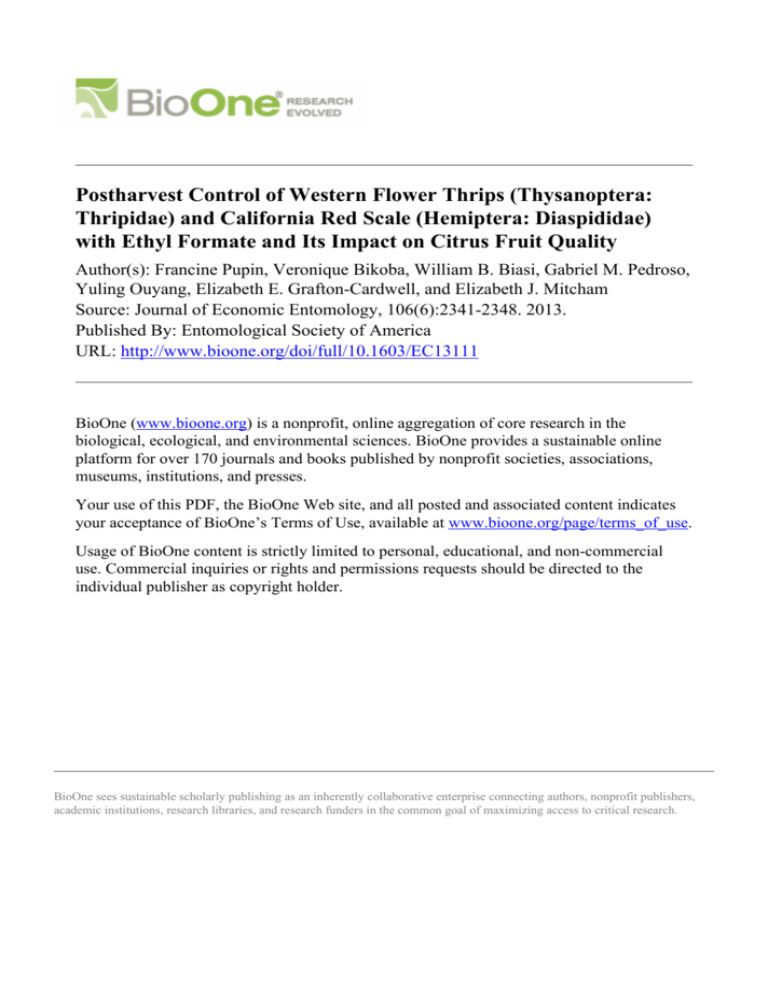
Postharvest Control of Western Flower Thrips (Thysanoptera: Thripidae) and California Red Scale (Hemiptera: Diaspididae) with Ethyl Formate and Its Impact on Citrus Fruit Quality Author(s): Francine Pupin, Veronique Bikoba, William B. Biasi, Gabriel M. Pedroso, Yuling Ouyang, Elizabeth E. Grafton-Cardwell, and Elizabeth J. Mitcham Source: Journal of Economic Entomology, 106(6):2341-2348. 2013. Published By: Entomological Society of America URL: http://www.bioone.org/doi/full/10.1603/EC13111 BioOne (www.bioone.org) is a nonprofit, online aggregation of core research in the biological, ecological, and environmental sciences. BioOne provides a sustainable online platform for over 170 journals and books published by nonprofit societies, associations, museums, institutions, and presses. Your use of this PDF, the BioOne Web site, and all posted and associated content indicates your acceptance of BioOne’s Terms of Use, available at www.bioone.org/page/terms_of_use. Usage of BioOne content is strictly limited to personal, educational, and non-commercial use. Commercial inquiries or rights and permissions requests should be directed to the individual publisher as copyright holder. BioOne sees sustainable scholarly publishing as an inherently collaborative enterprise connecting authors, nonprofit publishers, academic institutions, research libraries, and research funders in the common goal of maximizing access to critical research. COMMODITY TREATMENT AND QUARANTINE ENTOMOLOGY Postharvest Control of Western Flower Thrips (Thysanoptera: Thripidae) and California Red Scale (Hemiptera: Diaspididae) With Ethyl Formate and Its Impact on Citrus Fruit Quality FRANCINE PUPIN,1,2 VERONIQUE BIKOBA,1 WILLIAM B. BIASI,1 GABRIEL M. PEDROSO,1,3 YULING OUYANG,4 ELIZABETH E. GRAFTON-CARDWELL,4 AND ELIZABETH J. MITCHAM1 J. Econ. Entomol. 106(6): 2341Ð2348 (2013); DOI: http://dx.doi.org/10.1603/EC13111 ABSTRACT The postharvest control of arthropod pests is a challenge that the California citrus industry must overcome when exporting fruit overseas. Currently, methyl bromide fumigation is used to control postharvest pests on exported citrus, but it may soon be unavailable because of use restrictions and cost of this health-hazard ozone-depleting chemical. Ethyl formate is a natural plant volatile and possible alternative to methyl bromide in postharvest insect control. The objectives of this study were 1) to evaluate the mortality of third instar California red scale [Aonidiella aurantii (Maskell)] (Hemiptera: Diaspididae) and adult western ßower thrips [Frankliniella occidentalis (Pergande)] (Thysanoptera: Thripidae) under a wide range of ethyl formate concentrations, 2) to determine the ethyl formate concentration required to reach a Probit 9 level of control for both pests, and 3) to test the effects of ethyl formate fumigation on the quality of navel oranges [Citrus sinensis (L.) Osbeck] and lemons [Citrus limon (L.) Burman f.] at 24 h after fumigation, and at different time periods to simulate shipping plus storage (5 wk at 5⬚C), and shipping, storage, handling, and shelf-life (5 wk at 5⬚C, plus 5 d at 15⬚C, and 2 d at 20⬚C). The results indicate that ethyl formate is a promising alternative to methyl bromide for the California citrus industry, because of successful control of adult western ßower thips and third instar California red scale and no deleterious effect on fruit quality at any of the evaluated periods and quality parameters. KEY WORDS fumigation, lemon, orange, phytosanitary, Vapormate Postharvest control of arthropod pests to prevent their accidental introduction into countries where they do not occur is one of the challenges that the California citrus industry must overcome when exporting fruit overseas. California red scale [Aonidiella aurantii (Maskell)] (Hemiptera: Diaspididae) and western ßower thrips [Frankliniella occidentalis (Pergande)] (Thysanoptera: Thripidae) are among pests that require postharvest control. The navel of sweet oranges [Citrus sinensis (L.) Osbeck] can provide overwintering sites for several thrips species, including western ßower thrips, bean thrips [Caliothrips fasciatus (Pergande)], and citrus thrips [Scirtothrips citri (Moulton)]. Although western ßower thrips is not considered a pest of citrus, it is a pest of many other agricultural crops, because of both direct feeding damage and indirect damage through the transmission of viral diseases, including tomato 1 Department of Plant Sciences, University of California, One Shields Ave., Davis, CA 95616. 2 Corresponding author, e-mail: pupinf@gmail.com. 3 Department of Soils, Faculty of Agricultural Sciences, Federal University of Rio Grande do Sul, Bento Goncalves Ave, Porto Alegre, Brazil. 4 Department of Entomology, University of California, University Ave, Riverside, CA 92521. spotted wilt virus (Reitz 2009). Western ßower thrips may be transported overseas inside navel orange, being a quarantined pest for many commodities exported to Taiwan, including citrus. California red scale is a problematic pest in California because of its detrimental effect on citrus tree health and fruit yield and quality (Flint et al. 1991). Postharvest control of western ßower thrips and California red scale is imperative to avoid introduction of those insects in countries where they are absent. Currently, methyl bromide fumigation is used for all export citrus arriving in South Korea. In addition, methyl bromide is occasionally used in various other countries if pests are present. However, there are a number of problems associated with the use of methyl bromide fumigation, such as toxicity to workers and damage to citrus fruit, decreasing the commodity commercial value. In addition, methyl bromide has been identiÞed as an ozone depletor, and its use is restricted in accordance with the Montreal Protocol (Williams et al. 2000). Although exemptions exist for the use of methyl bromide in quarantine treatments, there are concerns about the future availability and cost of this fumigant (Mitcham 2001). The export of citrus fruit may soon be restricted unless an alternative insect control treatment is developed. 0022-0493/13/2341Ð2348$04.00/0 䉷 2013 Entomological Society of America 2342 JOURNAL OF ECONOMIC ENTOMOLOGY Ethyl formate is a naturally produced plant volatile that has been traditionally used as a fumigant to control insects in dried fruit (Vincent and Lindgren 1972, Desmarchelier et al. 1999). This low molecular weight compound readily hydrolyzes into formic acid and ethanol in the presence of water (Desmarchelier 1999). The use of a natural volatile as a fumigant poses a lower health hazard to humans in comparison with other fumigants such as methyl bromide (Aharoni et al. 1980). Ethyl formate was previously registered in the United States for control of stored-product pests, but the registration expired in the 1980s (Simpson et al. 2007). A new formulation of ethyl formate, Vapormate (Linde Gas, Murray Hill, NJ), was recently registered for postharvest insect control in New Zealand, Australia, The Philippines, Israel, South Korea, and Indonesia, and the registration in the United States is expected soon. Vapormate is formulated in a pressure cylinder (57.3 bar) as a mixture that contains 16.7% ethyl formate by weight in liquid carbon dioxide (CO2), which when vaporized gives 11% ethyl formate in gaseous CO2. CO2 reduces ethyl formate ßammability and acts as a propellant during ethyl formate fumigation (Lawrence 2005). Previous studies have demonstrated successful control of western ßower thrips and California red scale with ethyl formate fumigation. Aharoni et al. (1987) reported a preliminary study with complete control of California red scale on harvested grapefruit with ethyl formate fumigation concentration of 46.5 g/m3 for 3 h at 21⬚C. However, a doseÐmortality relationship curve was not established to determine the dose required for a Probit 9 level of control of the scale. In addition, the evaluation of the effects of ethyl formate on grapefruit quality only included general appearance of the fruit. Furthermore, the fumigation was not tested at periods of time shorter than 3 h. Simpson et al. (2007) reported 100% mortality of adult western ßower thrips in table grapes after a 1-h fumigation at 24⬚C with 10.2 g/m3 of ethyl formate. Western ßower thrips were also completely controlled on harvested strawberries by fumigation under vacuum with 15.5 g/m3 of ethyl formate for 1 h at 21⬚C, with no effects on berry quality (Aharoni et al. 1980). Moreover, Simpson et al. (2004) reported little to no calyx damage on strawberries after three 1-h applications of 24.7 g/m3 of ethyl formate at 24⬚C. Although these results are promising for the use of ethyl formate, the effects of ethyl formate fumigation on fruit quality need to be evaluated after longer periods, as export involves time-consuming processes such as shipping, storage, handling, and shelf-life. Nevertheless, ethyl formate may be a viable alternative to methyl bromide fumigation for exported citrus, preventing disruption in export shipments to South Korea and other countries because of limitation, phase-out, or both, of methyl bromide. The objectives of this study were 1) to conÞrm the efÞcacy of postharvest ethyl formate fumigations for the control of California red scale and western ßower thrips on citrus fruit; 2) to determine the concentrations required to reach Probit 9 level of control for Vol. 106, no. 6 those pests; and 3) to evaluate the effects of ethyl formate fumigation on the quality of oranges and lemons [Citrus limon (L.) Burm. f.] after simulated overseas shipping, storage, handling, and shelf-life. Materials and Methods Overview. The experiment was divided into two stages. The Þrst stage evaluated the mortality of western ßower thrips and California red scale after fumigation for 1 h with different concentrations of ethyl formate delivered from Vapormate cylinders. The doseÐmortality data were used to generate a mortality curve to predict the concentration of ethyl formate that would provide a Probit 9 level of control of each pest. The second stage of the experiment evaluated the effects of ethyl formate fumigation at the highest predicted dose for Probit 9 control between the two pests on navel orange and lemon fruit quality parameters. Fumigant Application. The insect mortality trials were performed with infested fruit fumigations (more information on infested fruit below). Fumigations were conducted at normal atmospheric pressure in 28.3-liter Þberglass chambers (Labconco vacuum desiccator, model 5530000, Labconco Corp., Kansas City, MO). Vapormate was vaporized using a heated regulator (The Linde Group, Murray Hill, NJ). Air was withdrawn from the chamber to create a vacuum of 100 millibars with the laboratory vacuum system, and the vaporized gas from the liquid Vapormate cylinder was collected in a 50-ml acrylic syringe and injected into the vessel. Different ethyl formate concentrations during the fumigations were obtained by injecting different amounts of Vapormate in the chambers, calculated based on the ethyl formate concentration obtained from the cylinder (340.8 g/m3), chamber volume (28.3 liter), and desired ethyl formate fumigation concentration (several concentrations, see Western Flower Thrips Mortality Trials). If there was still vacuum inside the chamber, the injection port was open to allow air to get inside and stabilize with atmospheric pressure, after which the port was closed. To ensure that the proper ethyl formate concentration had been achieved, headspace air samples were collected by syringe periodically during the fumigation and analyzed for ethyl formate concentration with a gas chromatograph (Shimadzu ScientiÞc Instruments, GC9AM, Inc., Columbia, MD) using a ßame ionization detector and a 60/80 carbopack B/5% carbowax 20M column. The fumigation time began when the required amount of Vapormate was fully introduced in the chamber. A 165-liter polyvinyl chloride air tight tank was used to evaluate the effect of ethyl formate on fruit quality. Similarly to the mortality trial fumigations, air was withdrawn from the fumigation vessels to create a vacuum of 100 millibars, and the vaporized gas from the liquid Vapormate cylinder was collected in 2,000-ml acrylic syringe and injected into the vessel. A gas detector with an ethyl formate sensor (Multi-gas detector, model G450, GfG Instrumentation, Ann Ar- December 2013 PUPIN ET AL.: CONTROL OF THRIPS AND SCALES WITH ETHYL FORMATE Table 1. Average insect mortality ⴞSE of California red scale and western flower thrips fumigated with several concentrations of ethyl formate Western ßower thrips California red scale Dose (g/m3) Mortality (⫾ SE; %) Dose (g/m3) Mortality (%) 0.0 1.5 2.3 3.1 4.6 5.4 5.8 6.2 6.6 3.4 ⫾ 1.8 8.7 ⫾ 1.5 19.7 ⫾ 1.7 68.2 ⫾ 2.3 96.0 ⫾ 2.1 98.9 ⫾ 0.9 100.0 ⫾ 0.0 100.0 ⫾ 0.0 100.0 ⫾ 0.0 0.0 1.5 3.1 4.6 6.2 7.7 9.3 10.8 12.4 13.9 15.5 17.0 18.6 20.1 21.7 3.1 ⫾ 1.5 0.0 ⫾ 0.0 1.3 ⫾ 1.1 22.5 ⫾ 1.8 63.8 ⫾ 6.2 84.2 ⫾ 1.8 80.0 ⫾ 7.1 80.0 ⫾ 2.5 95.0 ⫾ 0.0 90.0 ⫾ 1.8 99.2 ⫾ 0.8 98.8 ⫾ 1.1 98.8 ⫾ 1.1 100.0 ⫾ 0.0 100.0 ⫾ 0.0 bor, MI) was placed inside the chamber to continuously monitor and ensure that ethyl formate concentrations were correct and stable during the fumigation. The fumigation time began when the required amount of Vapormate was fully introduced in the vessel. Western Flower Thrips Mortality Trials. A colony of western ßower thrips was maintained in the laboratory to provide adults for the mortality experiment. Western Flower thrips adults were obtained from AgraQuest, located in Davis, CA, to initiate the colony. The adults were placed inside ventilated 474-ml cups with two green beans (Phaseolus sp.), and maintained at 25⬚C and a photoperiod of 12:12 (L:D) h. Once the adults laid eggs in the beans, the pods containing eggs were transferred to fresh containers. Emerged thrips fed on the beans, and the adults were collected for use in fumigation trials. The Þrst set of adults was used for fumigations 3 wk after the colony was started. This process was repeated for colony maintenance and future collection of adults. Navel oranges were infested with adult western ßower thrips using the method described by Harman et al. (2007). The bottom of a 2-cm-long and 2.5-cmdiameter clear plastic cup was cut off, and the remaining cup attached and sealed over the navel of the orange with adhesive putty (Loctite removable mounting putty, Avon, OH). An average of 45 adult thrips were placed into each attached cup, and a vented lid was snapped on to keep the insects in the cup but allowing for gas penetration. Two rubber bands were used to secure the cup and lid in place during the fumigation. Infested oranges were kept at 5⬚C for 1 d to drive the thrips into the navel. The experiment was designed with three replications with three subsamples. Each 28.3-liter chamber represented one replication, with three oranges per replication as subsamples. The fruit were fumigated for 1 h with eight different ethyl formate concentrations ranging from 0 to 6.7 g/m3 (Table 1), totaling 24 fumigated chambers. Ethyl formate concentrations were determined based on previous preliminary mortality tests performed in the laboratory. Replications 2343 of the same concentration were performed in the same day, and all fumigations were completed in 3 wk. The infested navel oranges were removed from cold storage (5⬚C) and immediately fumigated to keep the thrips inside the fruit. After fumigation, the oranges were aired for 1 h and held at 20⬚C for 24 h before mortality assessment, performed under a stereomicroscope. Insects remaining in the cup were gently transferred onto white paper for observation. The orange was then thinly sliced multiple times below the navel to observe remaining insects within the navel. Mortality was determined by lack of movement when insects were prodded. California Red Scale Mortality Trials. Lemons infested with California red scale were obtained from the UC Kearney Agricultural Center, located in Parlier, CA. This colony was initiated in 1993 from an unsprayed backyard citrus tree in Porterville, CA. Unripe lemons were infested with Þrst instar California red scale by placing the fruit on top of crawler-producing, scale-infested lemons for 24 h at 27 ⫾ 2⬚C. About 4 wk after infestation, when third instar females had developed, lemons were transported to the Postharvest Laboratory at UC-Davis for fumigation. The experiment was performed with third instar female scales because they are most resistant to insecticides (GraftonÐCardwell et al. 1998). Four lemons were placed inside each 28.3-liter Þberglass chamber, each fruit representing one replication. On each fruit, 20 viable female scales were identiÞed by marking a circle around them before fumigation. Only these 20 scales were used for mortality assessment. Fruit were fumigated for 1 h at 20⬚C with 15 different ethyl formate concentrations ranging from 0 to 21.7 g/m3 (Table 1), totaling 15 fumigated chambers. After each fumigation, the lemons were aired for 1 h and held at 20⬚C overnight before being transported back to UC Kearney Agricultural Center, where the fruit were placed in a growth chamber at 26⬚C, 50% relative humidity (RH), and a photoperiod of 16:8 (L:D) h. Scale mortality was assessed 48 h after the control females produced crawlers, ⬇3 wk after fumigation. Females were considered dead if no crawlers were produced. Testing Fruit Tolerance. Commercially packed, export grade navel oranges, size 88, and lemons, size 120, were obtained in April 2012 from a packing house located in Linden, CA. The fruit were harvested from the same orchard and cooled to 5⬚C for 24 h before being washed, waxed, packed in cardboard boxes, and transported to UC-Davis on the same day. The packed fruit were stored at 5⬚C until the day of the treatment. On average, the treatments were imposed 10 d after the beginning of storage. The experiment was designed with two treatments (treated and untreated control), three replications, and two fruit boxes per replication as subsamples, totaling six boxes of navel oranges and six boxes of lemons per treatment. The fruits were fumigated with ethyl formate at the higher of the two concentrations required to reach a Probit 9 level of control of California red scale and western ßower thrips (38 g/m3; 2344 JOURNAL OF ECONOMIC ENTOMOLOGY Table 2. at 20°C Vol. 106, no. 6 Probit analysis of dose–mortality data for western flower thrips and California red scale after 1-h fumigation with ethyl formate Pest Slope Int. n df 2 Hetero. Probitsa Control level (%) Estimated EF conc. (g/m3) Western ßower thrips Par. SE 9.92 0.809 ⫺4.619 0.403 781 28 18.8 0.67 6.64 7.33 8.09 8.72 9 95 99 99.9 99.99 99.99683 4.3 5.0 6.0 6.9 7.4 4.0Ð4.6 4.6Ð5.6 6.64 7.33 8.09 8.72 9 95 99 99.9 99.99 99.99683 12.8 17.6 25.0 33.4 38.1 11.8Ð14.1 15.7Ð20.2 California red scale Par. SE 4.983 0.296 ⫺3.876 0.276 1100 53 66.6 1.25 95% CI 6.0Ð8.8 31.4Ð48.8 Par., parameter; Int., intercept; Hetero., heterogeneity; EF, ethyl formate. a Added 5 to POLO probits to get adjusted traditional probits. Table 2). Oranges and lemons were removed from cold storage 15 h before fumigation and equilibrated at 20⬚C. Two boxes (one replication) of fruit were placed in a 165-liter polyvinyl chloride tank for fruit tolerance trials. The fumigation process was subsequently repeated three times (with different sets of fruit boxes) in the same day, representing three replications. The untreated control received the same cooling, storage, and fumigation (vacuum and temperature-wise) processes, with the exception that no ethyl formate was injected into the fumigation vessel. Quality Evaluation. The quality of lemons and oranges was evaluated at three different times after fumigation, to simulate shipping, storage, handling, and shelf-life. The Þrst evaluation was 24 h after fumigation, the second evaluation was after 5 wk storage at 5⬚C to simulate 3 wk of sea shipment plus 2 wk additional cold storage, and the third evaluation was performed after 5 wk at 5⬚C plus 5 d at 15⬚C and 2 d at 20⬚C, to simulate shipping and storage, plus handling and shelf-life. Forty randomly selected fruit from each replication (20 fruit selected from each box) were evaluated at each simulated exporting step. Fruit were evaluated nondestructively for Þrmness, external color, decay, and peel damage. Oranges and lemons were scored for decay and peel damage on a scale of 1Ð5, with 1 ⫽ none, 2 ⫽ very slight, 3 ⫽ slight, 4 ⫽ moderate, and 5 ⫽ severe. Firmness was measured using a Texture Analyzer (Texture Technologies Corp., A-HD Plus, Scarsdale, NY) Þtted with a 50-mm-diameter round stainless steel ßat plate. Firmness was expressed as the force in newtons (N) required compressing the fruit 10 mm from the contact point. Skin color was measured objectively using a Minolta Chromameter (MinoltaÐ Konica, CR-400, Japan) on two opposite sides of each fruit. The values were expressed by the CIE L*a*b* color scale system, where L* represents lightness of the color, a* represents the color position between red and green, and b* represents the color position between yellow and blue. The L*a*b* values were converted to hue angle (ho) using the formula hab ⫽ tan⫺1(b*/a*) (McGuire 1992). The 40 fruit used for visual quality evaluation and Þrmness were subsequently separated into four groups of 10 fruits. A wedge was cut from each of the 10 fruits and compiled for juicing, resulting in four juice subsamples per replication. Each juice sample was placed in a 50-ml plastic cup and used to determine soluble solids content, titratable acidity, and ethanol content. The results of the subsamples were averaged for data analysis. Titratable acidity was determined by titrating 4 g of juice with 0.1 N NaOH using an automatic TitraLab titrator (Radiometer Analytical, TIM950, Villeurbanne Cedex, France). Soluble solids content was measured using a digital refractometer (Reichert Technologies, AR6 Series, Depew, NY). Ethanol was determined by gas chromatography (Mitcham and McDonald 1993). A 5-ml juice sample was transferred to an 18-ml glass tube and capped with a septum. Samples were incubated at 65⬚C for 1 h in a water bath. Using a glass syringe, 1 ml of headspace gas was collected and injected into a gas chromatograph. Ethanol was identiÞed and quantiÞed by comparison to peak areas from gas samples extracted after incubation of a known standard solution. For formic acid analysis, Þve extra fruit were randomly selected from each box (10 fruits per replication). The fruit were peeled, and the ßesh was frozen in liquid N2, ground to a powder, and stored at ⫺20⬚C until analysis. A formic acid detection kit (Megazyme International Ireland, K-FORM, Wicklow, Ireland) was used to analyze the samples. The samples were prepared according to the kit instructions. Fifty grams of frozen fruit powder was blended with 100 ml of water, stirred for 15 min, quantitatively transferred to a 250-ml volumetric ßask, and adjusted to the mark with distilled water. The mixture was combined with NAD⫹ and formate dehydrogenase solution in a buffer at pH 7.6. In the presence of NAD⫹, formic acid is oxidized to CO2 by formate dehydrogenase with the stoichiometric formation of NADH. The concentration of NADH formed was measured with a spectrophotometer (Biochrom Libra Instruments, S22 UV/ Vis Spectrophotometer, Holliston, MA) at 340 nm. December 2013 Table 3. PUPIN ET AL.: CONTROL OF THRIPS AND SCALES WITH ETHYL FORMATE 2345 Relationship between insect mortality (%) and log of ethyl formate concentration (g/m3) Pest Estimated regression R2 P value Western ßower thrips California red scale y ⫽ ⫺45.57 ⫹ 183.38x y ⫽ ⫺24.9 ⫹ 101.28x 0.8628 0.8792 ⬍0.0001 ⬍0.0001 SE Slope Intercept 14.87 5.1 9.39 5.29 Linear regression model: y, insect mortality; x, log of ethyl formate concentration; R2, regression coefÞcient (regression mean square/total sum of squares). Data Analysis. Linear regressions of the observed western ßower thrips and California red scale mortality and log of ethyl formate concentration were performed in Sigma Plot (Systat Software, San Jose, CA) to analyze the effect of ethyl formate fumigation on insect mortality. DoseÐmortality data were analyzed with POLO Plus (LeOra Software Company, Petaluma, CA) to estimate the regression equation of Probit insect mortality and the dose required to achieve a 95, 99, 99.99, and Probit 9 level of control of California red scale and western ßower thrips at 95% conÞdence level. The observed insect mortality were manually converted to Probits using the FinneyÕs table (Finney 1952) and subsequently plotted with the log of ethyl formate concentration in Sigma Plot. CoefÞcients of determination (R2) of the observed data to the estimated POLO-calculated regression equation were obtained in Sigma Plot by manually determining values for the intercept and slope equation parameters in a linear regression. Quality evaluation data were analyzed for normality and constant variance of errors, and transformations were performed when assumptions were violated. The fumigation treatments were compared within each storage period. Analyses of variance were performed using PROC GLM in SAS (SAS Institute, Cary, NC) with TukeyÐKramerÕs method for mean separation. Differences were considered to be signiÞcant at the 5% probability level. Results and Discussion Western Flower Thrips Mortality. One-hour fumigation of adult western ßower thrips in infested fruit trials with ethyl formate concentrations of and above 5.8 g/m3 resulted in 100% insect mortality (Table 1). About 10% of the adult thrips were observed inside of the navel orange by thinly slicing the fruit. The linear regression results showed a highly signiÞcant (P ⬍ 0.0001) positive (slope ⫽ 183.38) effect of ethyl formate on western ßower thrips mortality (Table 3). The predicted dose to reach a Probit 9 (99.9968%) level of control of western ßower thrips adults was 7.4 g/m3 (95% CI of 6.0 Ð 8.8 g/m3; Table 2). Simpson et al. (2007) reported similar results. In their study, the concentrations necessary to reach 99% mortality of western ßower thrips adults in table grapes were 6.2 and 10.2 g/m3 of ethyl formate in 10% CO2 and air, respectively, for 1 h at 24⬚C. There was a good correlation (R2 ⫽ 0.83) between the observed insect mortality data and the POLO-predicted Probit equation (Fig. 1), indicating a good level of conÞdence in the results. California Red Scale Mortality. The ethyl formate dose required to achieve 100% control of third instar female California red scales was approximately four times greater than for western ßower thrips (Table 1). Fumigation with ethyl formate concentrations of and above 20.1 g/m3 showed 100% scale mortality. A highly Fig. 1. Plots of probit analysis of western ßower thrips to log of ethyl formate concentration (g/m3). Predicted values are for estimated 99, 99.9, 99.99, and Probit 9 level of insect mortality. The dashed vertical line intersect the log of ethyl fomate concentration to achieve a Probit 9 level of control. The coefÞcient of determination (R2) indicates the goodness-of-Þt of the observed data to the estimated POLO-calculated regression equation (subtract 5 from intercept to get POLO-calculated values as in Table 2). 2346 JOURNAL OF ECONOMIC ENTOMOLOGY Vol. 106, no. 6 Fig. 2. Plots of probit analysis of California red scale to log of ethyl formate concentration (g/m3). Predicted values are for estimated 99, 99.9, 99.99, and Probit 9 level of insect mortality. The dashed vertical line intersect the log of ethyl fomate concentration to achieve a Probit 9 level of control. The coefÞcient of determination (R2) indicates the goodness-of-Þt of the observed data to the estimated POLO-calculated regression equation (subtract 5 from intercept to get POLO-calculated values as in Table 2). signiÞcant (P ⬍ 0.0001) positive (slope ⫽ 101.28) effect of ethyl formate on red scale mortality was observed (Table 3). The POLO-predicted dose for Probit 9 level of control of California red scale was Þve times greater than for western ßower thrips (Table 2). The Probit 9 mortality of third instar scale females was estimated at 38.1 g/m3 (95% CI of 31.4 Ð 48.8 g/m3; Table 2; Fig. 2). The coefÞcient of correlation between the observed insect mortality data and the POLOpredicted Probit equation was high (R2 ⫽ 0.81; Fig. 2). Similar results have been reported in the literature. Aharoni et al. (1987) showed 100% mortality of all California red scale life stages with 46.4 g/m3 ethyl formate fumigation for 3 h at 21⬚C. The estimated ethyl formate concentration (38.1 g/m3) to reach a Probit 9 level of control of California red scale would also control other pests, such as grape mealybug [Pseudococcus maritimus (Ehrhorn)] adults and crawlers, as well as western ßower thrips eggs, pupae, and larvae (Simpson et al. 2007). However, these results should be validated with conÞrmation tests with larger numbers of insects on a commercial set up before ethyl formate is adopted by the California citrus industry. Table 4. Effect of ethyl formate fumigation for 1 h at 38 g/m3 on navel orange quality during simulated shipping, storage, handling, and shelf-life Attribute Firmness (N) Soluble solids content (%) Titratable acidity (%) Ethanol (ppm) Formic acid (mg/liter) Skin color (H) Treatment Initiala Shipping ⫹ storageb Ship ⫹ storage ⫹ shelf-lifec Control Treated SigniÞcance level Control Treated SigniÞcance level Control Treated SigniÞcance level Control Treated SigniÞcance level Control Treated SigniÞcance level Control Treated SigniÞcance level 48.11 46.68 NSd 14.51 14.45 NS 0.63 0.69 NS 222.37 231.93 NS 2.56 2.92 NS 67.59 68.35 NS 43.31 42.91 NS 14.47 14.47 NS 0.61 0.63 NS 293.25 380.54 NS 3.40 4.20 NS 67.70 67.89 NS 39.35 40.13 NS 14.19 14.28 NS 0.60 0.59 NS 423.46 493.51 NS 3.63 3.79 NS 68.06 68.14 NS Fumigation treatments were compared within each evaluation time. Differences between treatments were considered signiÞcant when P ⬍ 0.05. a 24 h at 20⬚C after fumigation. b 5 wk at 5⬚C. c 5 wk at 5⬚C, plus 5 d at 15⬚C, plus 2 d at 20⬚C. d NS, not signiÞcant. December 2013 Table 5. shelf-life PUPIN ET AL.: CONTROL OF THRIPS AND SCALES WITH ETHYL FORMATE 2347 Effect of ethyl formate fumigation for 1 h at 38 g/m3 on lemon quality during simulated shipping, storage, handling, and Attribute Firmness (N) Soluble solids content (%) Titratable acidity (%) Ethanol (ppm) Formic acid (mg/liter) Skin color (H) Treatment Initiala Shipping ⫹ storageb Ship ⫹ storage ⫹ shelf-lifec Control Treated SigniÞcance level Control Treated SigniÞcance level Control Treated SigniÞcance level Control Treated SigniÞcance level Control Treated SigniÞcance level Control Treated SigniÞcance level 48.39 46.10 NSd 8.13 8.09 NS 1.31 1.16 NS 146.26 141.03 NS 3.05 3.84 NS 94.79 94.29 NS 39.65 44.98 NS 7.72 7.80 NS 1.22 1.23 NS 172.14 150.31 NS 4.94 5.49 NS 93.19 92.91 NS 41.96 43.24 NS 7.64 7.73 NS 1.24 1.27 NS 245.54 229.12 NS 4.54 5.00 NS 92.12 92.54 NS Fumigation treatments were compared within each evaluation time. Differences between treatments were considered signiÞcant when P ⬍ 0.05. a 24 h at 20⬚C after fumigation. b 5 wk at 5⬚C. c 5 wk at 5⬚C, plus 5 d at 15⬚C, plus 2 d at 20⬚C. d NS, not signiÞcant. Fruit Tolerance. The predicted ethyl formate concentration to achieve a Probit 9 level of control was signiÞcantly greater for third instar female California red scale (38.1 g/m3) than for adult western ßower thrips (7.4 g/m3). Therefore, for fruit tolerance testing trials, the highest Probit 9 concentration between the two insects (38.1 g/m3) was used. Exposure to ethyl formate at 38 g/m3 was very well tolerated by navel oranges and lemons. There were no signiÞcant differences between untreated control and treated navel oranges and lemons at all three evaluation periods and for all quality parameters measured (Tables 4 and 5). In addition, treated and nontreated oranges and lemons had no mold or peel damage at any of evaluation periods (data not shown). Likewise, there were no signiÞcant differences in the levels of ethanol or formic acid between the treated and the control fruit at all evaluations (Tables 4 and 5), indicating no likely effect on fruit ßavor and no residues remaining after ethyl formate fumigation. Although many researchers have tested the efÞcacy of ethyl formate as a fumigant for pest control, few reports have described fruit tolerance, especially in experiments with fresh fruit. Our study showed no negative effect of ethyl formate on navel oranges and lemons at 38 g/m3 for 1 h and 20⬚C. However, fruit tolerance likely varies with commodity, dose, and time after fumigation. Table grapes fumigated with ethyl formate at concentrations as high as 160 g/m3 for 1 or 2 h tolerated the treatment with the exception of increased rachis browning; but after prolonged storage, the control treatment presented similar rachis browning (Simpson et al. 2007). Three 1-h applications of 24.7 g/m3 ethyl formate at 24⬚C caused no berry damage and little to no calyx damage on strawberries, but higher concentrations caused calyx browning (Simpson et al. 2004). In conclusion, our results indicate that ethyl formate is a promising substitute for methyl bromide for the control of adult western ßower thrips and third instar California red scales in citrus fruit. However, other pests may also need to be considered when developing a treatment schedule for the export of citrus fruit, depending on the market. In addition, conÞrmation tests with larger numbers of insects should be conducted to validate the efÞcacy of 38 g/m3 of ethyl formate treatment for Probit 9 level of control of third instar California red scale and adult western ßower thrips on a commercial scale. In addition, 1-h fumigation at 38 g/m3 of ethyl formate did not affect any of the navel orange and lemon quality parameters evaluated in any of the simulated shipping and storage periods. The results presented are promising for the use of ethyl formate as fumigant in the export of citrus from both insect control and fruit quality perspectives. References Cited Aharoni, Y., Y. Nitzan, and A. Copel. 1987. Natural volatiles to control the California red scale on harvested grapefruit. Trop. Sci. 27: 155Ð157. Aharoni, Y., J. K. Stewart, D. G. Guadagni, and T. R. Mon. 1980. Thrips mortality and strawberry quality after vacuum fumigation with acetaldehyde or ethyl formate. J. Am. Soc. Hortic. Sci. 105: 926 Ð929. Desmarchelier, J. M. 1999. Ethyl formate and formic acid: occurrence and environmental fate. Postharvest News Inf. 10: 7Ð12. Desmarchelier, J. M., F. M. Johnston, and L. T. Vu. 1999. Ethyl formate, formic acid and ethanol in air, wheat, barley and sultanas: analysis of natural levels and fumigant residues. Pestic. Sci. 55: 815Ð 824. Flint, M. L., B. Kobbe, J. K. Clark, S. H. Dreistadt, J. E. Pehrson, D. L. Flaherty, N. V. O’Connell, P. A. Phillips, and J. G. 2348 JOURNAL OF ECONOMIC ENTOMOLOGY Morse. 1991. Integrated pest management for citrus, 2nd ed. Publication 3303. University of California, Division of Agriculture and Natural Resources, Oakland, CA. Finney, D. J. 1952. Probit analysis, 2nd ed. Cambridge University Press, New York, NY. Grafton–Cardwell, E. E., Y. L. Ouyang, and J. Salse. 1998. Insecticide resistance and esterase enzyme variation in the California red scale (Homoptera: Diaspididae). J. Econ. Entomol. 91: 812Ð 819. Harman, J. A., C. X. Mao, L. J. Robinson, and J. G. Morse. 2007. Evaluation of two non-destructive sampling methods for bean thrips (Thysanoptera: Thripidae) detection in navel oranges. Crop Prot. 26: 1747Ð1754. Lawrence, L. 2005. Vapormate: an environmentally friendly fumigant. Outlooks Pest Manag. 16: 114 Ð115. McGuire, R. G. 1992. Reporting of objective color measurements. HortScience 27: 1254 Ð1255. Mitcham, E. 2001. Quarantine issues in 2000. Acta Hortic. 2: 451Ð 455. Mitcham, E. J., and R. E. McDonald. 1993. Respiration rate, internal atmosphere, and ethanol and acetaldehyde ac- Vol. 106, no. 6 cumulation in heat-treated mango fruit. Postharvest Biol. Technol. 3: 77Ð 86. Reitz, S. R. 2009. Biology and ecology of the western ßower thrips (Thysanoptera: thripidae): the making of a pest. Fla. Entomol. 92: 7Ð13. Simpson, T., V. Bikoba, and E. J. Mitcham. 2004. Effects of ethyl formate on fruit quality and target pest mortality for harvested strawberries. Postharvest Biol. Technol. 34: 313Ð319. Simpson, T., V. Bikoba, C. Tipping, and E. J. Mitcham. 2007. Ethyl formate as a postharvest fumigant for selected pests of table grapes. J. Econ. Entomol. 100: 1084 Ð1090. Vincent, L. E., and D. L. Lindgren. 1972. Hydrogen phosphide and ethyl formate: fumigation of insects infesting dates and other dried fruits. J. Econ. Entomol. 65: 1667Ð 1669. Williams, P., G. Hepworth, F. Goubran, M. Muhunthan, and K. Dunn. 2000. Phosphine as a replacement for methyl bromide for postharvest disinfestation of citrus. Postharvest Biol. Technol 19: 193Ð199. Received 5 March 2013; accepted 4 August 2013.


